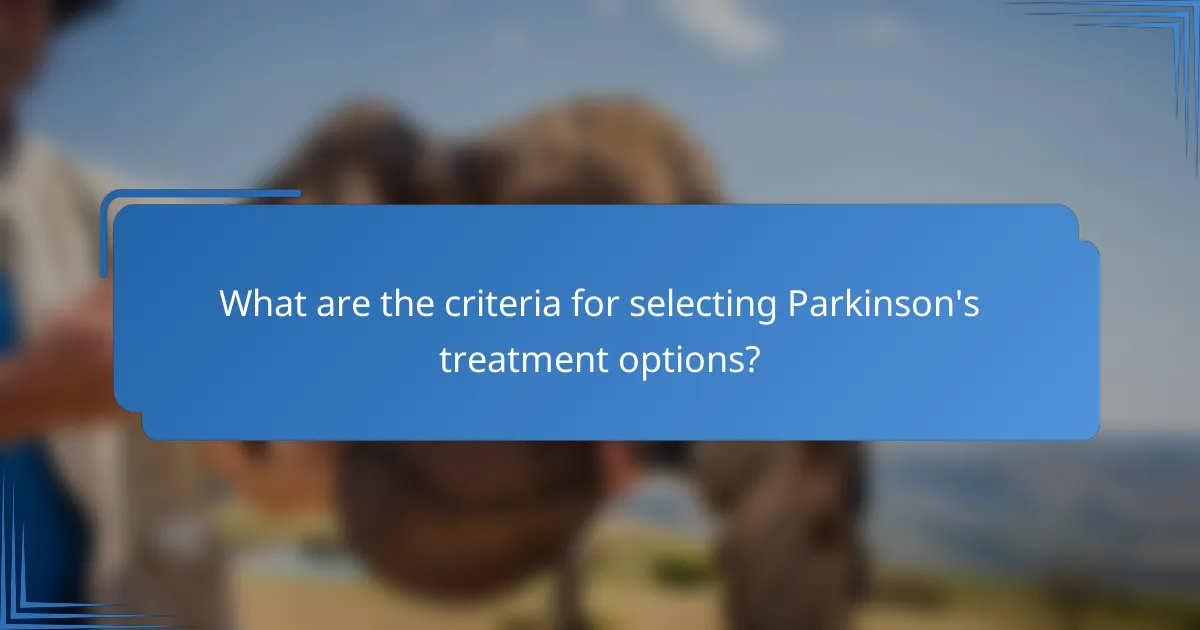The motor symptoms of Parkinson’s disease, including tremors, rigidity, and bradykinesia, can profoundly affect the daily lives of individuals. These symptoms lead to challenges in movement and coordination, necessitating a comprehensive approach to management that may involve medications, physical therapy, and other interventions tailored to each person’s needs.

What are the motor symptoms of Parkinson’s in New Zealand?
The motor symptoms of Parkinson’s disease in New Zealand primarily include tremors, rigidity, and bradykinesia. These symptoms can significantly impact daily activities and quality of life for those affected.
Tremors
Tremors are involuntary shaking movements that often occur at rest and can affect various body parts, particularly the hands. In New Zealand, these tremors may be noticeable when a person is relaxed, such as while sitting or lying down.
Typically, tremors in Parkinson’s patients start on one side of the body and can progress over time. They may vary in intensity and frequency, sometimes becoming more pronounced during periods of stress or fatigue.
Rigidity
Rigidity refers to stiffness and resistance to movement in the muscles, which can lead to discomfort and reduced range of motion. In New Zealand, individuals with Parkinson’s may experience rigidity in the arms, legs, and neck, making it difficult to perform everyday tasks.
This symptom can contribute to a stooped posture and may lead to muscle pain. Regular physical therapy and stretching exercises can help alleviate some of the stiffness associated with rigidity.
Bradykinesia
Bradykinesia is characterized by slowness of movement, making it challenging for individuals to initiate or complete tasks. In New Zealand, this symptom can manifest as difficulty in walking, reduced facial expressions, or a slower response to questions.
People experiencing bradykinesia may find that their movements become less fluid over time. Engaging in regular physical activity and occupational therapy can assist in maintaining mobility and function.

How can tremors be managed?
Tremors in Parkinson’s disease can be managed through a combination of medications, physical therapy, and assistive devices. Each approach has its own benefits and considerations, allowing for tailored treatment plans based on individual needs.
Medications like Levodopa
Levodopa is a primary medication used to manage tremors in Parkinson’s patients. It works by replenishing dopamine levels in the brain, which helps to reduce motor symptoms. Patients often start with low doses, gradually increasing as needed, while monitoring for side effects.
Other medications, such as dopamine agonists or anticholinergics, may also be prescribed alongside Levodopa to enhance its effects or manage side effects. Regular consultations with a healthcare provider are essential to adjust dosages and assess effectiveness.
Physical therapy options
Physical therapy can significantly improve motor function and reduce tremors. Therapists often design personalized exercise programs focusing on strength, balance, and coordination. Techniques such as stretching and resistance training can help maintain mobility and reduce stiffness.
Incorporating activities like tai chi or yoga may also be beneficial, as they promote relaxation and body awareness, which can help manage tremors. Regular sessions can lead to improved daily functioning and quality of life.
Assistive devices
Assistive devices can provide practical support for individuals experiencing tremors. Tools like weighted utensils, adaptive grips, and specialized writing instruments can help reduce the impact of tremors during daily tasks. These devices are designed to enhance control and stability.
Additionally, using devices such as handrails or grab bars in the home can improve safety and independence. Consulting with occupational therapists can help identify the most effective assistive devices tailored to individual needs and living environments.

What treatments are available for rigidity?
Treatments for rigidity in Parkinson’s disease aim to reduce muscle stiffness and improve mobility. Options include botulinum toxin injections, stretching exercises, and adjustments to medications.
Botulinum toxin injections
Botulinum toxin injections can effectively reduce rigidity by temporarily paralyzing the muscles responsible for stiffness. This treatment is particularly useful for localized areas, such as the neck or arms, where rigidity is most pronounced.
Patients typically receive injections every few months, and the effects can last several weeks. It’s essential to consult a healthcare provider to determine the appropriate dosage and injection sites.
Stretching exercises
Stretching exercises play a crucial role in managing rigidity by promoting flexibility and reducing muscle tightness. Regular stretching can help maintain range of motion and improve overall mobility.
Incorporating gentle stretches into daily routines, such as yoga or physical therapy, can be beneficial. Aim for at least 10-15 minutes of stretching several times a week, focusing on major muscle groups affected by rigidity.
Medication adjustments
Adjusting medications can significantly impact rigidity management. Common Parkinson’s medications, such as levodopa, may need to be fine-tuned to optimize their effects on muscle stiffness.
Consulting with a neurologist is vital for evaluating current medications and making necessary changes. Keeping a symptom diary can help track the effectiveness of adjustments and guide discussions with healthcare providers.

How is bradykinesia treated?
Bradykinesia, a common motor symptom of Parkinson’s disease, is treated through a combination of exercise programs, deep brain stimulation, and medication management. These approaches aim to improve movement speed and overall quality of life for individuals affected by this condition.
Exercise programs
Exercise programs are essential for managing bradykinesia, as they enhance mobility and strength. Activities like walking, swimming, and tai chi can help improve coordination and reduce stiffness. Aim for at least 150 minutes of moderate exercise per week, adjusting intensity based on individual capability.
Incorporating balance and flexibility exercises can further aid in preventing falls and improving overall function. Group classes or personal trainers experienced in Parkinson’s care can provide motivation and tailored routines.
Deep brain stimulation
Deep brain stimulation (DBS) is a surgical treatment option for individuals with advanced Parkinson’s disease experiencing significant bradykinesia. This procedure involves implanting electrodes in specific brain regions to regulate abnormal signals, which can lead to improved motor function.
DBS is typically considered when medication alone does not adequately control symptoms. Patients should discuss potential risks and benefits with their healthcare provider, as results can vary widely among individuals.
Medication management
Medication management is crucial for treating bradykinesia, with options including levodopa, dopamine agonists, and MAO-B inhibitors. Levodopa is often the first-line treatment, converting to dopamine in the brain to alleviate symptoms.
Regularly reviewing medication effectiveness and side effects with a healthcare provider is essential. Adjustments may be necessary to optimize treatment, and patients should be aware of potential interactions with other medications or dietary factors.

What are the criteria for selecting Parkinson’s treatment options?
Selecting treatment options for Parkinson’s disease involves evaluating symptom severity, patient lifestyle, and healthcare provider recommendations. These criteria help tailor a management plan that addresses individual needs and maximizes quality of life.
Symptom severity
The severity of motor symptoms such as tremors, rigidity, and bradykinesia plays a crucial role in treatment selection. Mild symptoms may be managed with lifestyle changes and monitoring, while more severe symptoms often require medication or advanced therapies.
Healthcare providers typically assess symptom severity using standardized scales, which can guide the choice of treatment. For instance, patients with significant bradykinesia might benefit from dopaminergic medications sooner than those with primarily tremor-dominant symptoms.
Patient lifestyle
Patient lifestyle factors, including daily activities, work commitments, and social interactions, significantly influence treatment decisions. A treatment plan that aligns with a patient’s routine can enhance adherence and overall satisfaction.
For example, an active individual may prefer medications that allow for more flexibility and fewer side effects, while someone with a more sedentary lifestyle might tolerate different options. It’s essential to consider how treatments will fit into the patient’s life.
Healthcare provider recommendations
Healthcare provider recommendations are vital in the treatment selection process for Parkinson’s disease. Providers assess the patient’s unique situation, including symptom profile and lifestyle, to suggest appropriate therapies.
Collaboration between the patient and healthcare team is crucial. Regular follow-ups allow for adjustments based on treatment efficacy and side effects, ensuring that the management plan remains effective and responsive to changing needs.

What are the latest advancements in Parkinson’s symptom management?
Recent advancements in managing Parkinson’s symptoms focus on enhancing patient care through technology and remote services. Innovations like wearable devices and telehealth platforms are transforming how symptoms such as tremors, rigidity, and bradykinesia are monitored and treated.
Wearable technology
Wearable technology for Parkinson’s management includes devices that track movement patterns and monitor symptoms in real-time. These gadgets can provide valuable data to healthcare providers, allowing for more personalized treatment plans.
Examples of wearable devices include smartwatches and specialized sensors that measure tremor intensity and frequency. Patients can benefit from continuous monitoring, which helps in adjusting medications and therapies more effectively.
Telehealth services
Telehealth services have become increasingly important in managing Parkinson’s symptoms, offering patients access to healthcare professionals from the comfort of their homes. This approach can reduce travel burdens and improve adherence to treatment plans.
Through virtual consultations, patients can discuss their symptoms and receive timely adjustments to their care. Telehealth can also facilitate group therapy sessions, providing support and education to those living with Parkinson’s.
